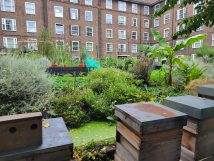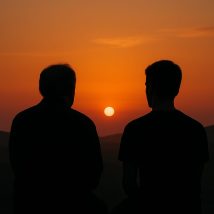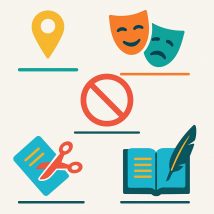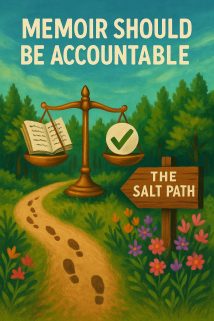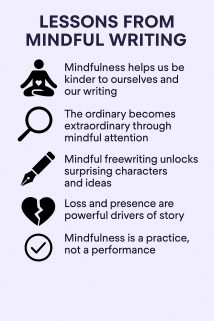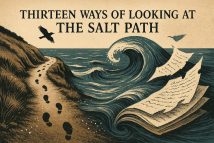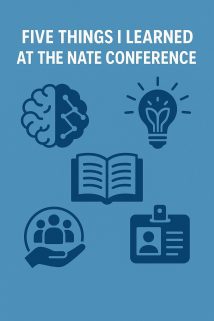Creative Writers
-
Writing Among Books and Roses: Five Lessons from the British Library and a South London Garden
This October, as autumn mist drifted across London, our MA Creative Writing and Education students embarked on two journeys that revealed how creativity grows wherever attention is cultivated — one in the British Library, the other in a South London garden. At the British Library, students began by getting their Reader’s Passes, a small but symbolic act of entry into a world of ideas. Each went on a quiet quest to find a book, manuscript, or object that spoke personally to them. One student of Mauritian heritage discovered colonial-era texts that illuminated her island’s past; another, from India, was drawn to the gleam of jewellery that recalled her grandmother’s only inheritance — her bangles. These encounters sparked reflective, poetic responses, showing how archives can awaken ancestral memory and imaginative connection. Later that week, the group met Ian, the Head Gardener — @theelephantgardener — who, with volunteers and modest grants, has transformed an estate’s communal garden into a flourishing haven of rhubarb, roses, and vegetables. The students weeded, listened, and wrote, finding that creative writing, like gardening, begins with observation and care. Both experiences taught us that creative writing doesn’t belong only to the elite or to “literary” spaces. It is a democratic, sensory practice that helps us connect — with the past, with nature, and with one another. Like Keats’s “Season of mists and mellow fruitfulness,” October reminded us that writing and gardening share a rhythm: gathering what’s ripe, planting what’s next. The writers are now planning projects to use libraries and gardens as creative classrooms — helping children, elders, and communities to grow stories from the soil beneath their feet.
-
Five Things I Learnt from Running My Workshop at Ecology in the Art Curriculum event
Begin with breathing, end with agency Our recent CPD, run by the British Ecological Society, the Centre for Arts and Learning, the MA in Art and Ecology, and the PGCE Art and Design programme at Goldsmiths, brought together teachers, artists, and ecologists to explore how mindfulness and creative pedagogy can help students reconnect with the natural world. We began simply, with a 7–11 breathing pattern, in for seven, out for eleven, and the room shifted. Teachers found themselves calmer, more attentive, and ready to imagine. A guided visualisation led participants into remembered or imagined parks, awakening ecological awareness. One delegate described how “thinking about ecology in architecture always meant thinking about care, what lives around our buildings.” From that mindful pause grew dialogue, drawing, and story. Participants wrote, sketched, and mapped experiences of safety, resilience, and belonging. Multimodality helped everyone find a voice, whether through words, images, or textures, and teachers began to see how pupils could express complex feelings about public space. Stories carried particular weight. The tale of the cracked pot, a vessel that leaks water and nurtures flowers on its path, became a metaphor for resilience and repair. Teachers shared their own narratives of strength and imperfection, connecting personal reflection with community action. By the end, delegates were planning how to adapt these approaches in their own settings, mapping safe routes with pupils, collaborating with councils, and gathering data to balance perception and reality. Change, we realised, does not arrive as a slogan but travels through networks of small, mindful acts. As I suggest in The Mindful Creative Writing Teacher, small rituals of attention such as breathing, noticing, and creating build agency. They help us move from reflection to action, from seeing to doing, with care.
-
The Lady from the Sea: Five Lessons We’ve Lost in Translation
Simon Stone’s new adaptation of Ibsen’s The Lady from the Sea at the Bridge Theatre, starring Alicia Vikander and Andrew Lincoln, is exquisite and psychologically nuanced — yet something vital has ebbed away. In translating Ibsen’s Fruen fra havet into modern English realism, the production trades myth for therapy, danger for empathy. This article explores five lessons the original still teaches us (about desire, freedom, landscape, symbolism, and voice) and what is lost when we tame the sea into a lake.
-
Seven Things I Learnt from Land of the Free? Trump’s War on Press, Protest and Academic Freedom
What does freedom of expression really mean in 2025? On August 5th, I attended a deeply thought-provoking event hosted by Index on Censorship at St John’s Church, Waterloo, where my wife Erica Wagner was one of the speakers. The panel launched the new Index issue titled Land of the Free? and gathered journalists, editors, and activists to reflect on Donald Trump’s legacy and the erosion of civil liberties across the US and UK. From SLAPP lawsuits to the criminalisation of protest, the conversation reminded us that freedom is not a given: it must be defended, questioned, and collectively sustained. This blog distils seven key lessons I took away from the night, ranging from the legacy of the War on Terror to the global assault on so-called “woke” values. #FreedomOfExpression #IndexOnCensorship #LandOfTheFree #ProtestRights #SLAPPs #CultureWars #Democracy #WritersLife #PoliticalWriting #CreativeNonfiction #EricaWagner #FrancisGilbert #HumanRights #SpeakUp #UKPolitics #USPolitics
-
Seven Things I Learnt from The Ballad of Wallis Island
I wrote this blog in response to The Ballad of Wallis Island, a quietly beautiful film that spoke to something deep in me, as a writer, teacher, and person drawn to stories of retreat and reckoning. Watching it reminded me that we all carry a kind of island within us: a place where our creative selves, our ghosts, our pasts and possibilities gather. The film’s setting, tone, and themes of faded fame, broken love, and slow healing made me reflect on what happens when we stop performing and start listening; to others, and to ourselves. That inner island became a metaphor I couldn’t shake. The blog explores this in depth, ending with a poem and a creative visualisation for those wanting to travel inward themselves. Writing it helped me rediscover a part of my own creative practice. I hope it does something similar for you. If you’re reading this on Instagram, please paste the link into your browser to access the full piece at www.francisgilbert.co.uk
-
Eight Transformative Moments from Our Reciprocal Teaching Day at Goldsmiths
🖋️ “It didn’t have to be clever. It just had to be true.” At a recent MA Creative Writing and Education sharing day, alumna Maryam Ahmadi led a powerful storytelling session exploring how fables can carry emotional and moral truths that essays and arguments often can’t. The bold linocut-style image here captures the spirit of the session: a teacher and group of students surrounded by symbols of learning and connection—a heart, a lightbulb, a book, and leaves. A chalkboard shows the simplest of equations: 1 + 1, reminding us that real learning is reciprocal. When we share stories, we’re not just transmitting knowledge—we’re transforming one another. Maryam began by reading Patrick and Flippa, a deceptively gentle children’s book about a lonely polar bear and a persistent penguin. The group then wrote their own fables, revealing themes of exile, regeneration, defiance, and hope. One participant wrote about a deer who could only speak in questions. Another told of a fish who forgot how to swim in clean water. These were not writing exercises. They were acts of quiet truth-telling. 💡 As one attendee put it: “It’s easier to say something difficult through the story of a fox. You get closer without flinching.” 📚 This workshop was part of the MA in Creative Writing and Education at Goldsmiths, University of London—a unique programme where writers become educators, and educators deepen their creative practice. 🔗 Find out about the MA: www.gold.ac.uk/pg/ma-creative-writing-education/ #MACreativeWritingAndEducation #GoldsmithsUniversity #StorytellingAsPedagogy #MindfulTeaching #Fables #CreativeWritingWorkshop #WritingToHeal #WritingToLearn #RadicalPedagogy #TeacherWriter #ReciprocalLearning
-
Six Things The Salt Path Can Teach Us About Publishing, Truth, and the Power of Memoir
I wrote this blog after reflecting on The Salt Path by Raynor Winn and its powerful impact, not just as a personal story, but as a case study in how publishing shapes truth, healing, and cultural desire. Drawing on over a decade of teaching creative writing and publishing, I explore what the book teaches us about agents, editors, marketing, and the ethics of memoir. 👣 Who decides what gets published—and how truth is framed? 📚 Why do memoirs like this resonate so deeply? 🧭 What role does publishing play in offering hope or illusion? 🔗 Read the full post here: https://www.francisgilbert.co.uk/2025/07/six-things-the-salt-path-can-teach-us-about-publishing-truth-and-the-power-of-memoir/ #TheSaltPath #RaynorWinn #PublishingEthics #CreativeWriting #Memoir #Pedagogy #WritingLife #FrancisGilbert #Goldsmiths
-
How Much Truth Is Enough? Reflecting on Raynor Winn’s Response to The Observer
What happens when the story you loved starts to shift? In this piece, I explore Raynor Winn’s recent public defence of The Salt Path—a statement both moving and evasive. While condemning the abuse Winn has received, the article interrogates what her response reveals (and conceals) about the ethics of memoir. Did the omissions distort the truth? What kind of trust do memoirists owe their readers? And when real-life complexities surface, do they deepen a story—or destabilise it? This isn’t about cancellation—it’s about accountability, narrative framing, and the quiet power of what’s left unsaid. #MemoirEthics #RaynorWinn #TheSaltPath #NarrativeTruth #LifeWriting #CreativeNonfiction #MindfulWriting #EthicalStorytelling #WritingCommunity
-
Ten Ethical Complexities of Memoir: After The Salt Path, and Two Decades After My Own
In my last post, I explored Thirteen Ways of Looking at The Salt Path. This follow-up dives deeper. Raynor Winn’s The Salt Path moved many. But recent reporting has raised ethical questions about omission, accountability, and the seduction of “emotional truth.” What are the responsibilities of the memoirist—especially when their story brings them sympathy, sales, or status? In this new article, I reflect on my own memoir—and what I got wrong. I explore what I’ve learned as a writer, teacher, and mentor of emerging voices on the MA in Creative Writing and Education at Goldsmiths. 🧭 Memoir is a journey, not a monument. 🕊️ Truth needs ethics, not just emotion. 🌊 The Salt Path leads us to difficult but necessary questions. 🔗 Link in bio/comments #MemoirMatters #EmotionalTruth #CreativeWriting #TheSaltPath #EthicalWriting #FrancisGilbert #WritersOfInstagram #NonFictionNarratives #GoldsmithsWriters
-
Five Reasons Why Mindfulness and Creative Writing Weave Together Well
What happens when we stop judging our writing—and simply listen? In this new blog post, I reflect on a recent workshop where writers used mindfulness to unlock voice, memory, and emotion. Together we explored how freewriting, object meditation, and mindful noticing can transform both what we write and how we feel about writing. Participants wrote about lipstick, tissue packets, Kindles—and discovered surprising characters, deep emotional truths, and stories of presence, loss, and joy. These moments reminded us that mindfulness is not about calming down—it’s about showing up. Drawing on my book The Mindful Creative Writing Teacher (Gilbert, 2025) and C. T. McCaw’s concept of “thick mindfulness,” I share five practical and poetic takeaways from the session. If you teach, write, or are simply curious about the link between awareness and creativity, this one’s for you. 💡 Read now and see how mindful writing can be radically freeing. #MindfulWriting #CreativeWritingTeacher #Freewriting #MindfulnessInEducation #WritersOfInstagram #AmWriting #WritingWorkshop #GoldsmithsUniversity #FrancisGilbert #WritingPrompt #MindfulLiving
-
Thirteen Ways of Looking at The Salt Path After the Truth Came Out
I wrote this blog because, like so many readers, I had been profoundly moved by The Salt Path and felt shocked and saddened by the revelations in The Observer’s investigation. My piece, Thirteen Ways of Looking at The Salt Path, reflects the emotional complexity of this moment. It explores how we process betrayal, how beauty can be real even when built on broken foundations, and how storytelling must be held to ethical account. This is not a takedown. It is not an attempt to erase what people found meaningful in Sally and Tim Walker’s journey. Instead, it is an invitation to hold the story up to the light and examine its layers. I use the structure of Wallace Stevens’ poem Thirteen Ways of Looking at a Blackbird to acknowledge the many truths that can coexist, and the importance of distinguishing between them. This is a moment for honesty in publishing, compassion for those misled, and responsibility for those harmed. It is also a call for readers, writers, and teachers to think more deeply about what it means to tell the truth. I hope this blog opens a space for reflection and dialogue, about literature, justice, and the real salt of life.
-
Why English Teaching Still Matters: Insights from the 2025 NATE Conference
What does it mean to teach English with creativity, care, and courage in 2025? At this year’s NATE (National Association for the Teaching of English) conference, I joined a passionate group of teachers, academics, publishers, and educational innovators, some seasoned, others just starting out, to explore that very question. In this new blog post, I reflect on five powerful lessons from a day filled with poetic metaphors, Generation Alpha pedagogy, and mindful creative writing. From Clare Lawrence’s unforgettable lentil metaphor, to conversations about inclusive teaching for a post-2010 cohort, to the joyful solidarity of English educators nationwide: this was a conference where research met emotion, and practice met possibility. I also had the pleasure of leading a mindful creative writing workshop, inspired by my book The Mindful Creative Writing Teacher (Gilbert, 2025), and saw first-hand how freeing and transformative creative writing can be when rooted in reflection rather than performance. If you care about teaching English in ways that centre imagination, identity, and student voice, and want to explore this further, take a look at our MA in Creative Writing and Education at Goldsmiths. 🔗 MA info: https://www.gold.ac.uk/pg/ma-creative-writing-education/ #MindfulWriting #NATE2025 #CreativePedagogy #EnglishTeachers #TeacherCommunity #FrancisGilbert #MindfulCreativeWritingTeacher
-
Let Poetry Jump Up: Five Key Ways to Teach Poetry Effectively
Let Poetry Jump Up: Five Powerful Ways to Teach Poetry I wrote this blog after attending a fantastic workshop led by the brilliant Fiona Plant, a warm and inspiring poetry educator. Her session was a powerful reminder of how poetry can create joy, connection, and confidence in the classroom. Fiona shared five inclusive, creative approaches that make poetry teaching feel fresh and purposeful—ranging from “I Am…” Post-it Poems and metaphor games to redacted newspaper poetry and the thoughtful use of sensory prompts. She also explored how to use the CASTERS lesson planning framework (which I developed) to bring intention, reflection, and creativity into every stage of the process. Most strikingly, Fiona urged us to model the process of writing—not just share polished work. When children see poetry unfold, with all its mess and magic, they begin to see themselves as writers too. You can find Fiona’s slides, activity ideas, and lots more in the full blog post on my website: 👉 www.francisgilbert.co.uk If you’d like to receive occasional curated updates about creative writing, education, and mindful teaching, you can sign up here: 👉 www.francisgilbert.co.uk/subscribecontact/ #PoetryTeaching #MindfulLearning #CreativeWriting #FrancisGilbert #CASTERSFramework #FionaPlant #TeacherInspiration #EduBlog

